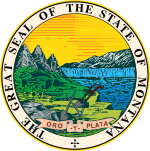
The 1972 United States Senate elections were held on November 7, with the 33 seats of Class 2 contested in regular elections. They coincided with the landslide re-election of Republican President Richard Nixon. Despite Nixon's landslide victory, Democrats increased their majority by two seats. The Democrats picked up open seats in Kentucky and South Dakota, and defeated four incumbent senators: Gordon Allott of Colorado, J. Caleb Boggs of Delaware, Jack Miller of Iowa, and Margaret Chase Smith of Maine. The Republicans picked up open seats in New Mexico, North Carolina, and Oklahoma, and defeated one incumbent, William B. Spong Jr. of Virginia.

Arnold Olsen was a U.S. Democratic politician who served as the Attorney General of Montana from 1949 to 1957, and as a member of the United States House of Representatives from Montana's 1st congressional district from 1961 to 1971.
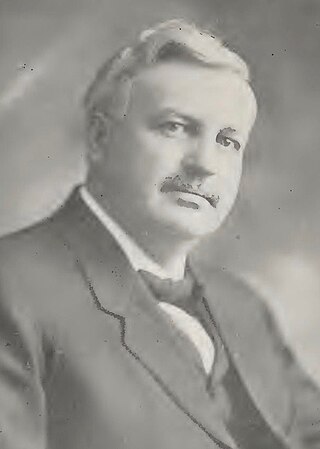
Samuel Vernon Stewart was an American attorney and Democratic Party politician, an attorney, former Montana Supreme Court Justice and the sixth Governor of Montana.

The 1918 United States Senate election in Montana took place on November 5, 1918. Incumbent United States Senator Thomas J. Walsh, who was first elected to the Senate in 1912, ran for re-election. He won the Democratic primary uncontested, and was opposed in the general election by Oscar M. Lanstrum, a former State Representative and the Republican nominee, and Jeannette Rankin, one of two United States representatives from Montana's at-large congressional district and the nominee of the National Party. Walsh narrowly won his second term in the Senate.
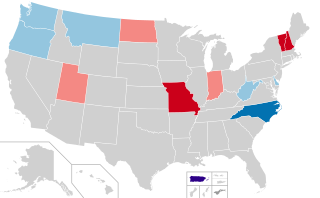
United States gubernatorial elections were held on November 8, 2016, in 12 states and two territories. The last regular gubernatorial elections for nine of the 12 states took place in 2012. The last gubernatorial elections for New Hampshire, Oregon, and Vermont took place in 2014, as Oregon held a special election due to the resignation of Governor John Kitzhaber, while the governors of New Hampshire and Vermont both serve two-year terms. The 2016 gubernatorial elections took place concurrently with several other federal, state, and local elections, including the presidential election, Senate, and House elections.

The 1924 United States Senate election in Montana took place on November 4, 1924. Incumbent United States Senator Thomas J. Walsh, who was first elected to the Senate in 1912 by the state legislature, and re-elected in 1918 by popular vote, ran for re-election. He was unopposed in the Democratic primary.
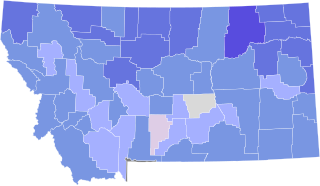
The 1930 United States Senate election in Montana took place on November 3, 1936. Incumbent United States Senator James E. Murray, who was first elected to the Senate in a special election in 1934, ran for re-election. He narrowly emerged from a competitive and close Democratic primary, wherein he was challenged by United States Congressman Joseph P. Monaghan, who represented Montana's 1st congressional district. In the general election, Murray was opposed by Thomas O. Larson, a State Senator and the Republican nominee, and Monaghan, who, after losing the primary, ran as an independent candidate. Murray ended up winning a second term, and his first full term, in a landslide, defeating both of his opponents by a comfortable margin.

The 1922 United States Senate election in Montana took place on November 7, 1922. Incumbent United States Senator Henry L. Myers, who was first elected to the Senate in 1910, and was re-elected in 1916, declined to seek re-election. Former United States Attorney Burton K. Wheeler won the Democratic primary and advanced to the general election, where he faced Carl W. Riddick, the United States Congressman from Montana's 2nd congressional district and the Republican nominee. Ultimately, Wheeler defeated Riddick comfortably and won his first term in the Senate.

The 1928 United States Senate election in Montana took place on November 6, 1928. Incumbent United States Senator Burton K. Wheeler, who was first elected to the Senate in 1922, ran for re-election. After successfully defeating several challengers in the Democratic primary, Wheeler advanced to the general election, where he faced Republican nominee Joseph M. Dixon, the former Governor of Montana who had previously served in the United States Senate from 1907 to 1913. Though the election was closer than Wheeler's first election, he still managed to defeat Dixon to win his second term in the Senate.
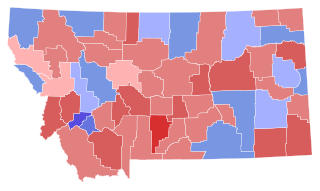
The 1988 Montana gubernatorial election took place on November 8, 1988. Incumbent Governor of Montana Ted Schwinden, who was first elected in 1980 and was re-elected in 1984, declined to seek re-election to a third term, creating an open seat. Stan Stephens, the former president of the Montana Senate, won a close Republican primary, and advanced to the general election, where he was opposed by Thomas Lee Judge, Schwinden's predecessor as governor and the Democratic nominee. Though the general election was hotly contested, Stephens ultimately defeated Judge, becoming the first Republican to win a gubernatorial election in Montana since 1964.

The 1968 Montana gubernatorial election took place on November 5, 1968. Incumbent Governor of Montana Tim Babcock, who became Governor upon the death of previous Governor Donald Grant Nutter and was elected in 1964, ran for re-election. He faced serious competition in the Republican primary from his Lieutenant Governor, but managed to comfortably win renomination. Advancing to the general election, Babcock faced Forrest H. Anderson, the Attorney General of Montana and the Democratic nominee, and independent candidate Wayne Montgomery of the New Reform Party. Ultimately, Anderson managed to defeat Babcock by a solid margin, winning his first and only term as governor. As of 2023, this is the last time an incumbent Governor of Montana lost re-election.

The 1956 Montana gubernatorial election took place on November 6, 1956. Incumbent governor of Montana J. Hugo Aronson, who was first elected Governor in 1952, ran for re-election. He was unopposed in the Republican primary and advanced to the general election, where he faced Arnold Olsen, the Attorney General of Montana and the Democratic nominee. Despite the fact that then-President Dwight D. Eisenhower won the state in a landslide that year in the presidential election, Aronson only narrowly defeated Arnold to win his second and final term as governor.

The 1940 Montana gubernatorial election took place on November 5, 1940. Incumbent Governor of Montana Roy E. Ayers, who was first elected governor in 1936, ran for re-election. He narrowly won the Democratic primary by just over a thousand votes to win renomination, and advanced to the general election, where he was opposed by Sam C. Ford, a former Associate Justice of the Montana Supreme Court and the Republican nominee. Ultimately, in spite of the fact that then-President Franklin D. Roosevelt comfortably won the state in that year's presidential election, Ford narrowly defeated Ayers to win his first of two terms as governor.

The 1936 Montana gubernatorial election took place on November 3, 1936. Incumbent Governor of Montana Elmer Holt, who became governor in 1935 upon the death of Frank Henry Cooney, ran for re-election. He was challenged in the Democratic primary by a number of challengers, and was narrowly defeated for renomination by United States Congressman Roy E. Ayers of Montana's 2nd congressional district. Ayers advanced to the general election, where he faced Frank A. Hazelbaker, the former Lieutenant Governor of Montana and the Republican nominee. Following a close election, Ayers narrowly defeated Hazelbaker to win what would be his first and only term as governor.

The 1932 Montana gubernatorial election took place on November 8, 1932. Incumbent Governor of Montana John E. Erickson, who was first elected governor in 1924 and was re-elected in 1928, ran for re-election. He won the Democratic primary with a plurality and advanced to the general election, where he faced Frank A. Hazelbaker, the Lieutenant Governor of Montana. Despite the fact that Franklin D. Roosevelt carried the state in a landslide in the presidential election that year, Erickson only narrowly defeated Hazelbaker to win re-election to his third and final term as governor, though he would later resign just a few months into his term to appoint himself to the United States Senate.

The 1928 Montana gubernatorial election took place on November 6, 1928. Incumbent Governor of Montana John E. Erickson, who was first elected governor in 1924, ran for re-election. Erickson only narrowly won the Democratic primary against future Governor Roy E. Ayers, and advanced to the general election, where he was opposed by U.S. Attorney Wellington D. Rankin, the former Attorney General of Montana. Although Herbert Hoover carried the state in a landslide in the presidential election that year, Erickson won re-election to his second term as governor in a landslide over Rankin.

The 1924 Montana gubernatorial election took place on November 4, 1924. Incumbent Governor of Montana Joseph M. Dixon, who was first elected governor in 1920, ran for re-election. Dixon won a competitive Republican primary, and moved on to the general election, where he faced John E. Erickson, a former district court judge and the Democratic nominee; and Frank J. Edwards, the 1916 Republican nominee for governor and the Farmer–Labor Party nominee. Ultimately, Erickson managed to defeat Dixon in his bid for re-election, winning what would be the first of three terms as governor.
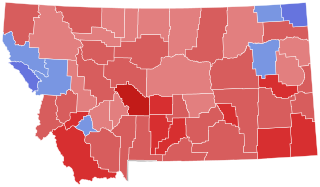
The 1920 Montana gubernatorial election took place on November 2, 1920. Incumbent Governor of Montana Sam V. Stewart, who was first elected Governor in 1912 and 1916, declined to run for re-election. To replace him, former United States Senator Joseph M. Dixon won the Republican primary, which was closely contested. In the general election, he faced Burton K. Wheeler, the former United States Attorney for the District of Montana and the Democratic nominee. Ultimately, Dixon defeated Wheeler by a wide margin to win his first and only term as governor.

A general election was held in the U.S. state of Wyoming on Tuesday, November 3, 1914. All of the state's executive officers—the Governor, Secretary of State, Auditor, Treasurer, and Superintendent of Public Instruction—were up for election. Governor Joseph M. Carey declined to seek re-election to a second term, and Democratic State Senator John B. Kendrick was elected as his successor. Republicans, however, won all of the other statewide executive offices, including picking up the Superintendent's office.

A general election was held in the U.S. state of Wyoming on Tuesday, November 5, 1918. All of the state's executive officers—the Governor, Secretary of State, Auditor, Treasurer, and Superintendent of Public Instruction—were up for election. Republicans won all statewide offices by wide margins, and with Robert D. Carey's defeat of Frank L. Houx, picked up the governorship following two consecutive losses to Democrats.

